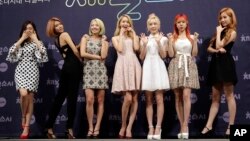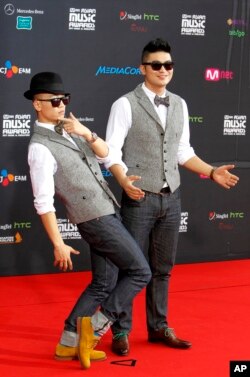The clothes, the hair, the confidence — the look of Korean pop music can feel like high fashion or just plain quirky. But that's what draws fans to South Korea's most famous musical export.
As much as the music and lyrics themselves, the perfectly symmetrical stars and the meticulous choreography define K-pop for a country obsessed with image and beauty.
And if you've managed to elude the beats and flash of its music and videos until now, rest assured it will be hard to bypass this cultural phenomenon during the Winter Olympics.
Among the most viewed YouTube videos of all time with more than 3 billion hits is Psy's 2012 earworm Gangnam Style. But that is hardly representative of the genre. It's actually a parody of K-pop drawing on its own absurdities, which experts say was fully embraced locally when it became a global touchstone of Korean culture.
Though the multibillion-dollar industry hasn't yet become truly mainstream in the U.S. and other Western countries, there's fanatical interest among millions of people old and young across Asia and in pockets of the rest of the world.
The South Korean people and government are proud of their infectious brand of music and music videos, which feature Korean lyrics dashed with catchy English phrases, vibrant fashion and elaborate dance moves. Its fans are famous for their devotion to their favorite bands, which has created a spin-off hobby involving a sizable number of Koreans gathering to re-create the complicated routines with seriousness and accuracy.
And in the U.S., American youth have driven demand for formal programs catering to their obsession. Clark Sorensen, Korea history professor and the director of the University of Washington's Center for Korea Studies in Seattle, said he developed official course material about three years ago because his students showed up to his Modern Korean Society class asking: Where's the K-pop?
"I just started doing it,'' the longtime anthropologist said. "They're interested in Korea because they're interested in K-pop.''
The K-pop industry began in the 1990s as the country was growing as a democracy and its profile rising on the world stage. It was thought to be used to harness its rich history of highly trained musicians and artists with the emergence of its homegrown high-tech expertise, said Keith Howard, a music history expert and National Humanities Center fellow. But what began as a movement to develop cultural entertainment for its own people gave way to a massive, rabid fan base beyond its borders.
The past decade saw another wave of K-pop that is far more commercial, as talent agencies develop rigorous training programs that capitalize on both the genre's appeal as an export and as a vessel for mass-market advertising and product marketing.
"It was very well placed to move very, very quickly to assimilating and appropriating Western music,'' Howard said.
What started as innocent bubblegum pop has lately taken an edgier turn. Nods to the mainstream American taste have produced Korean hits swept up in rap, hip-hop, R&B and reggae influences, as well as those that are more explicit and sexual. But that move hasn't been without criticism as observers have called it out as cultural appropriation that can be downright racist.
Here's a sample of some kinds of K-pop:
Bubblegum Pop
Gee by Girls' Generation is a reassuring taste of mainstream K-pop hit music, featuring simple but abundant dance moves performed by more than a half dozen females in matching casual and colorful outfits while they dance in a store, a nod to South Korea's other beloved pastime: mall shopping.
K-Hip-Hop
AEAO by Dynamic Duo sounds right at home as a hip-hop classic with melodic raps and hooks, moody lighting, break dancing and turntable scratching.
More Explicit
Hello Bitches by CL is a more sexualized, explicit form in this edgier evolution of K-pop, taking black leather and twerking to a new level for the genre.
Parody
Gangnam Style by Psy is a parody by a pudgy Korean entertainer with a signature horse-gallop dance move. But he registers as an "anti-Korean'' archetype among the very image-conscious, plastic surgery-embracing native population.











